Impact of Nitrogen Fertiliser Usage in Agriculture on Water Quality
Abstract
1. Introduction
2. Materials and Methods
2.1. Search Strategy
- Sign language on letters cause discrepancies, causing RefWorks to recognize them as different articles: For example, Author name “Lawniczak-Malinska, A.; Nowak, B.; Pajewski, K.” on Web of Science and “Lawniczak-Malińska, A.; Nowak, B.; Pajewski, K.” on Scopus, if you take a deep look at the bolded part you will notice a difference of language sign on letter “n”;
- There are cases where the author’s name is the same, but there is a difference in the title name due to a language sign in the letter and a missing letter. For example, the title name “Modelling impacts of a municipal spatial plan of land-use changes on surface water quality-example from Goriška Brda in Slovenia” on Scopus and “Modelling Impacts of a Municipal Spatial Plan of Land-Use Changes on Surface Water Quality-Example from Gorika Brda in Slovenia” on Web of Science. Again, if you check the bolded part, the sign language and misspelling caused the discrepancy;
- There is a case where the title is the same, and the abstract seems different, but after reading through both, it was clear that the abstract is the same. For example, “Assessment of extrinsic and intrinsic influences on water quality variation in subtropical agricultural multipond systems,” on GREENFILLE and “Assessment of extrinsic and intrinsic influences on water quality variation in subtropical agricultural multipond systems” on Scopus.
2.2. Screening
2.3. Quality Assessment
2.4. Statistical Analysis
2.4.1. Data Synthesis
2.4.2. Missing Data
2.5. Meta-Analysis Model
3. Results
3.1. Characteristics of the Included Studies
3.2. Results of the Meta-Analysis
3.2.1. Correlation Between Nitrogen Fertiliser Use and Water Pollution
3.2.2. Future Direction on the Impact of Fertiliser Use on Water Quality
3.3. Sensitivity Analysis
3.4. Assessment of Publication Bias
3.4.1. Funnel Plot Analysis
3.4.2. Classic Fail-Safe N Test
3.4.3. Orwin Fail-Safe N
3.4.4. Begg and Mazumdar Rank Correlation Test
3.4.5. Duval and Tweedie’s Trim and Fill
3.4.6. Egger’s Regression Test
4. Discussion
4.1. Interpretation of Findings
4.2. Environmental and Health Impacts
4.3. Mitigation Through Precision Agriculture
4.4. Understanding Heterogeneity
4.5. Limitations
4.6. Future Research Directions
5. Conclusions
Funding
Conflicts of Interest
Appendix A
| Pilot Search | Database | Search String | Result |
|---|---|---|---|
| First search | Science direct | (“fertilizer” OR “Agricultural fertilizer” OR “NPK fertilizer”) AND (“water pollution” OR “water quality” OR “ water contaminantion”) AND (“Climate change” OR “Extreme weather” OR “Climate condition”) | 6690 |
| Second search | Science direct | (“agriculture” OR “farming practices” OR “crop production”) AND (“nutrient runoff” OR “fertilizer runoff” OR “agricultural runoff”) AND (“environmental impact” OR “ecosystem health” OR “environmental sustainability”) | 2660 |
| Web of Science | (“Agricultural” OR “Farm”) AND (“Nitrogen fertilizer” OR “N-fertilizer” OR “fertilizer” OR “Nutrient”) AND (“water pollution” OR “water contamination” OR “water quality” OR “ Eutrophication”) AND (“Extreme weather” OR “Storm” OR “runoff” OR “Climate change” OR “Climate condition”) (Topic) and 2024 or 2023 or 2022 or 2021 or 2020 (Publication Years) | 747 |
| PICO Framework | Research Objective | Keywords | Synonyms |
|---|---|---|---|
| Population | Agriculture | Agriculture, Agricultural runoff | Faming practice, crop production |
| Intervention | Nitrogen fertilizer usage | Nitrogen fertilizer | Nitrate, N fertilizer |
| Comparison | - | - | - |
| Outcome | Impact on water quality | Impact, water, water quality, water polution | Effect, consequence, surface water, groundwater, lake, river, water contamination, eutrophication, algal bloom, nitrate pollution |
| Database | Search String | Result |
|---|---|---|
| Scopus | TITLE-ABS-KEY ((“nitrogen fertilizer” OR “nitrate” OR “agricultural runoff”) AND (“water pollution” OR “water quality” OR “eutrophication” OR “algal blooms” OR “nitrate pollution”) AND (“agriculture” OR “farming practices” OR “crop production”) AND (“impact” OR “effects” OR “consequences”) AND (“surface water” OR “groundwater” OR “rivers” OR “lakes”)) AND PUBYEAR > 2019 AND PUBYEAR < 2025 AND (LIMIT-TO (LANGUAGE,”English”)) | 514 |
| Web of Science | (“nitrogen fertilizer” OR “nitrate” OR “agricultural runoff”) AND (“water pollution” OR “water quality” OR “eutrophication” OR “algal blooms” OR “nitrate pollution”) AND (“agriculture” OR “farming practices” OR “crop production”) AND (“impact” OR “effects” OR “consequences”) AND (“surface water” OR “groundwater” OR “rivers” OR “lakes” (Topic) and 2023 or 2022 or 2024 or 2021 or 2020 (Publication Years) and English (Languages) | 131 |
| GREENFILE | (“nitrogen fertilizer” OR “nitrate” OR “agricultural runoff”) AND (“water pollution” OR “water quality” OR “eutrophication” OR “algal blooms” OR “nitrate pollution”) AND (“agriculture” OR “farming practices” OR “crop production”) AND (“impact” OR “effects” OR “consequences”) AND (“surface water” OR “groundwater” OR “rivers” OR “lakes”) Limiters—Publication Date: 20200101–20241231 Narrow by Language:—English Search modes—Boolean/Phrase | 36 |
| Criteria | Inclusion | Exclusion |
|---|---|---|
| Year of Publication | 2020–2024 | Before 2020 |
| Journal type | Others | Systematic review, review, book series, letter, Editorial |
| Publication language | English | Non-English |
| Water sampling | 2019–2024 | Before 2019 |
| Water quality parameter | Nutrient or physico-chemical parameter | Other parameters |
| Pollution | Inorganic or nitrogen fertilizer | Manure, wastewater and other sources |
| Context of study | Agriculture | Others |
| Focus Area | Variable |
|---|---|
| Identification information | Author |
| Title of study | |
| Year of publication | |
| Study design | Study design |
| Location of study | |
| Study duration | |
| Fertilizer | Type of agriculture |
| Type of fertilizer | |
| Application rate | |
| Water quality parameters | Measured parameters |
| Sampling location or source | |
| Sampling interval | |
| Analytical method used | |
| Impact on water quality | Baseline water quality parameter |
| changes in water quality parameter due to effect of inorganic fertilizer | |
| spatial distribution of water quality changes | |
| Temporal or seasonal trends in water quality changes | |
| Other variables | Climate conditions |
| Land use/Land cover | |
| Management practice | |
| Results | summary of main findings |
| Any associations or correlations reported between fertilizer usage and water quality | |
| Quality assessment | Study methods |
| Result validity | |
| Study reliability |
Appendix B
References
- Kumar, N.; Kumar, A.; Marwein, B.; Verma, D.K.; Jayabalan, I.; Kumar, A.; Ramamoorthy, D. Agricultural Activities Causing Water Pollution and Its Mitigation—A Review. Int. J. Mod. Agric. 2021, 10, 2021. [Google Scholar]
- Ayana, E. Determinants of Declining Water Quality; World Bank: Washington, DC, USA, 2019. [Google Scholar] [CrossRef]
- Obilonu, A.; Chijioke, C.; Igwegbe, W.; Ibearugbulem, O.; Abubakar, Y. Water Quality Challenges and Impact. Int. Lett. Nat. Sci. 2013, 4, 44–53. [Google Scholar] [CrossRef][Green Version]
- Wouters, P. Global, Regional and Local Challenges; Institute for Public Policy Research (IPPR): London, UK, 2010; Available online: http://www.jstor.org/stable/resrep16067 (accessed on 1 February 2024).
- Cousin, E.; Kawamura, A.G.; Rosegrant, M.W. The Threat of Water Scarcity. In From Scarcity to Security; Chicago Council on Global Affairs: Chicago, IL, USA, 2019; pp. 12–25. Available online: http://www.jstor.org/stable/resrep21409.6 (accessed on 1 February 2024).
- United Nations Department of Economic and Social Affairs, Population Division. World Population Prospects 2022: Summary of Results; United Nations: New York, NY, USA, 2022; Available online: https://www.un.org/development/desa/pd/sites/www.un.org.development.desa.pd/files/wpp2022_summary_of_results.pdf (accessed on 5 February 2024).
- Nelson, A.R.L.E.; Ravichandran, K.; Antony, U. The impact of the Green Revolution on indigenous crops of India. J. Ethn. Foods 2019, 6, 8. [Google Scholar] [CrossRef]
- Walling, E.; Vaneeckhaute, C. Nitrogen Fertilizers and the Environment. In Nitrate Handbook; CRC Press: Boca Raton, FL, USA, 2022; pp. 103–135. [Google Scholar]
- Ghavam, S.; Vahdati, M.; Wilson, I.A.G.; Styring, P. Sustainable Ammonia Production Processes. Front. Energy Res. 2021, 9, 580808. [Google Scholar] [CrossRef]
- Tyldesley, A. Ammonium Nitrate, a Simple Fertiliser, or Dangerous Explosive? 1974. Available online: https://www.chem.ox.ac.uk/files/ks4ammoniumnitrate.pdf (accessed on 10 June 2025).
- Zayed, O.; Hewedy, O.A.; Abdelmoteleb, A.; Ali, M.; Youssef, M.S.; Roumia, A.F.; Seymour, D.; Yuan, Z.-C. Nitrogen Journey in Plants: From Uptake to Metabolism, Stress Response, and Microbe Interaction. Biomolecules 2023, 13, 1443. [Google Scholar] [CrossRef] [PubMed]
- Anas, M.; Liao, F.; Verma, K.K.; Sarwar, M.A.; Mahmood, A.; Chen, Z.-L.; Li, Q.; Zeng, X.-P.; Li, Y.-R. Fate of nitrogen in agriculture and environment: Agronomic, eco-physiological and molecular approaches to improve nitrogen use efficiency. Biol. Res. 2020, 53, 47. [Google Scholar] [CrossRef]
- Martínez-Dalmau, J.; Berbel, J.; Ordóñez-Fernández, R. Nitrogen Fertilization. A Review of the Risks Associated with the Inefficiency of Its Use and Policy Responses. Sustainability 2021, 13, 5625. [Google Scholar] [CrossRef]
- Liu, C.-W.; Sung, Y.; Chen, B.-C.; Lai, H.-Y. Effects of Nitrogen Fertilizers on the Growth and Nitrate Content of Lettuce (Lactuca sativa L.). Int. J. Environ. Res. Public Health 2014, 11, 4427–4440. [Google Scholar] [CrossRef]
- Dimkpa, C.O.; Fugice, J.; Singh, U.; Lewis, T.D. Development of fertilizers for enhanced nitrogen use efficiency—Trends and perspectives. Sci. Total. Environ. 2020, 731, 139113. [Google Scholar] [CrossRef]
- Cassman, K.G.; Dobermann, A. Nitrogen and the future of agriculture: 20 years on. AMBIO 2021, 51, 17–24. [Google Scholar] [CrossRef]
- McIsaac, G. Surface Water Pollution by Nitrogen Fertilizers. In Encyclopedia of Water Science; CRC Press: Boca Raton, FL, USA, 2003. [Google Scholar]
- Mengel, D. AY-204; Purdue Extension: West Lafayette, IN, USA, 2019; Available online: https://www.extension.purdue.edu/extmedia/AY/AY-204.html (accessed on 15 March 2024).
- Guo, S.; Jiang, R.; Qu, H.; Wang, Y.; Misselbrook, T.; Gunina, A.; Kuzyakov, Y. Fate and transport of urea-N in a rain-fed ridge-furrow crop system with plastic mulch. Soil Tillage Res. 2019, 186, 214–223. [Google Scholar] [CrossRef]
- Singh, B.; Craswell, E. Fertilizers and nitrate pollution of surface and ground water: An increasingly pervasive global problem. SN Appl. Sci. 2021, 3, 518. [Google Scholar] [CrossRef]
- Giordano, M.; Petropoulos, S.A.; Rouphael, Y. The Fate of Nitrogen from Soil to Plants: Influence of Agricultural Practices in Modern Agriculture. Agriculture 2021, 11, 944. [Google Scholar] [CrossRef]
- Holden, J.; Haygarth, P.M.; MacDonald, J.; Jenkins, A.; Sapiets, A.; Orr, H.G.; Dunn, N.; Harris, B.; Pearson, P.L.; McGonigle, D.; et al. Agriculture’s Impacts on Water Quality; Global Food Security Programme: Swindon, UK, 2015. [Google Scholar]
- Vilas, M.P.; Thorburn, P.J.; Fielke, S.; Webster, T.; Mooij, M.; Biggs, J.S.; Zhang, Y.-F.; Adham, A.; Davis, A.; Dungan, B.; et al. 1622WQ: A web-based application to increase farmer awareness of the impact of agriculture on water quality. Environ. Model. Softw. 2020, 132, 104816. [Google Scholar] [CrossRef]
- Bashir, I.; Lone, F.A.; Bhat, R.A.; Mir, S.A.; Dar, Z.A.; Dar, S.A. Concerns and Threats of Contamination on Aquatic Ecosystems. In Bioremediation and Biotechnology; Hakeem, K.R., Bhat, R.A., Eds.; Springer: Cham, Switzerland, 2020; pp. 1–26. [Google Scholar] [CrossRef]
- Anderson, D.M.; Fensin, E.; Gobler, C.J.; Hoeglund, A.E.; Hubbard, K.A.; Kulis, D.M.; Landsberg, J.H.; Lefebvre, K.A.; Provoost, P.; Richlen, M.L.; et al. Marine harmful algal blooms (HABs) in the United States: History, current status and future trends. Harmful Algae 2021, 102, 101975. [Google Scholar] [CrossRef] [PubMed]
- Addy, K.; Green, L.; Herron, E. Nitrogen and Water Quality; University of Rhode Island, College of the Environment and Life Sciences: Kingston, RI, USA, 2005. [Google Scholar]
- Verma, A.; Sharma, A.; Kumar, R.; Sharma, P. Nitrate contamination in groundwater and associated health risk assessment for Indo-Gangetic Plain, India. Groundw. Sustain. Dev. 2023, 23, 100978. [Google Scholar] [CrossRef]
- Abushouk, A.I.; Yunusa, I.; Elmehrath, A.O.; Elmatboly, A.M.; Fayek, S.H.; Abdelfattah, O.M.; Saad, A.; Isogai, T.; Shekhar, S.; Kalra, A.; et al. Quality Assessment of Published Systematic Reviews in High Impact Cardiology Journals: Revisiting the Evidence Pyramid. Front. Cardiovasc. Med. 2021, 8, 671569. [Google Scholar] [CrossRef]
- Hogg, J. LibGuides: Systematic Reviews: Home. Available online: https://libguides.tees.ac.uk/systematic_reviews (accessed on 14 March 2024).
- Fischer, A.P.; Shah, M.A.R.; Segnon, A.C.; Matavel, C.; Antwi-Agyei, P.; Shang, Y.; Muir, M.; Kaufmann, R. The Global Adaptation Mapping Team Human adaptation to climate change in the context of forests: A systematic review. Clim. Risk Manag. 2023, 43, 100573. [Google Scholar] [CrossRef]
- Page, M.J.; McKenzie, J.E.; Bossuyt, P.M.; Boutron, I.; Hoffmann, T.C.; Mulrow, C.D.; Shamseer, L.; Tetzlaff, J.M.; Akl, E.A.; Brennan, S.E.; et al. The PRISMA 2020 statement: An updated guideline for reporting systematic reviews. BMJ 2021, 372, n71. [Google Scholar] [CrossRef]
- Furtak, K.; Wolińska, A. The impact of extreme weather events as a consequence of climate change on the soil moisture and on the quality of the soil environment and agriculture—A review. CATENA 2023, 231, 07378. [Google Scholar] [CrossRef]
- Kucaj, E.; Gjoni, I.A.; Osmani, M.; Çela, G.; Bardhi, A.; Baxhija, Z.; Kucaj, B. Impact of Human Activity on the Water Quality of Lake Mullinjëza, Belsh, Albania. In Proceedings of the 4th International Conference on Environmental Design (ICED 2023), Athens, Greece, 20–22 October 2023. E3S Web of Conferences. [Google Scholar] [CrossRef]
- Dahiya, D.; Laishram, B. Life cycle energy analysis of buildings: A systematic review. Build. Environ. 2024, 252, 111160. [Google Scholar] [CrossRef]
- King, N. LibGuides: Environment: Journal Articles & Databases. Available online: https://libguides.tees.ac.uk/environment/journal (accessed on 20 March 2024).
- Burnham, J.F. Scopus database: A review. Biomed. Digit. Libr. 2006, 3, 1. [Google Scholar] [CrossRef]
- Li, K.; Rollins, J.; Yan, E. Web of Science use in published research and review papers 1997–2017: A selective, dynamic, cross-domain, content-based analysis. Scientometrics 2017, 115, 1–20. [Google Scholar] [CrossRef] [PubMed]
- InCites Help Center Web of Science Research Areas. Available online: https://incites.help.clarivate.com/Content/Research-Areas/wos-research-areas.htm (accessed on 20 March 2024).
- GreenFILE|EBSCO. 2020. Available online: https://www.ebsco.com/products/research-databases/greenfile (accessed on 20 March 2024).
- Hozo, S.P.; Djulbegovic, B.; Hozo, I. Estimating the mean and variance from the median, range, and the size of a sample. BMC Med. Res. Methodol. 2005, 5, 13. [Google Scholar] [CrossRef]
- Stephanie. Combined Mean: Definition, Examples. Statistics How to. 2018. Available online: https://www.statisticshowto.com/combined-mean/ (accessed on 13 April 2024).
- Cochrane Training. Chapter 10: Analysing Data and Undertaking Meta-Analyses. Cochrane Training. 2024. Available online: https://training.cochrane.org/handbook/archive/v6.2/chapter-10#:~:text=Random%2Deffects%20meta%2Danalyses%20allow (accessed on 13 April 2024).
- Piscopo, A.; Seaman, S.C.; Beer, M.A.; Torner, J.C.; Greenlee, J.D. A meta-analysis of proportions of single arm observational series for anterior skull base meningiomas comparing supraorbital craniotomy to the endoscopic endonasal approach. Interdiscip. Neurosurg. 2021, 26, 101303. [Google Scholar] [CrossRef]
- Gutsmiedl, K.; Krause, M.; Bighelli, I.; Schneider-Thoma, J.; Leucht, S. How well do elderly patients with major depressive disorder respond to antidepressants: A systematic review and single-group meta-analysis. BMC Psychiatry 2020, 20, 102. [Google Scholar] [CrossRef]
- Bighelli, I.; Huhn, M.; Schneider-Thoma, J.; Krause, M.; Reitmeir, C.; Wallis, S.; Schwermann, F.; Pitschel-Walz, G.; Barbui, C.; Furukawa, T.A.; et al. Response rates in patients with schizophrenia and positive symptoms receiving cognitive behavioural therapy: A systematic review and single-group meta-analysis. BMC Psychiatry 2018, 18, 380. [Google Scholar] [CrossRef]
- Borenstein, M. Common Mistakes in Meta-Analysis and How to Avoid Them. Available online: https://www.Meta-Analysis-Books.com. (accessed on 22 March 2024).
- Borenstein, M.; Hedges, L.V.; Higgins, J.P.T.; Rothstein, H. Fixed-Effect Versus Random-Effects Models. Available online: https://meta-analysis.com/pages/books?cart= (accessed on 22 April 2024).
- Borenstein, M.; Hedges, L.V.; Higgins, J.P.T.; Rothstein, H.R. A basic introduction to fixed-effect and random-effects models for meta-analysis. Res. Synth. Methods 2010, 1, 97–111. [Google Scholar] [CrossRef]
- Hedges, L.V.; Vevea, J.L. Fixed- and random-effects models in meta-analysis. Psychol. Methods 1998, 3, 486–504. [Google Scholar] [CrossRef]
- Gomes, E.; Antunes, I.; Leitão, B. Groundwater management: Effectiveness of mitigation measures in nitrate vulnerable zones—A Portuguese case study. Groundw. Sustain. Dev. 2023, 21, 100899. [Google Scholar] [CrossRef]
- Diana, C.C.; Balint, A.C.; Neamțu, C.V.; Moșneag, S.C.; Bordea, D.; Dîrjan, S.; Odagiu, A.C.M. Assessment of Groundwater Quality in Relation to Organic versus Mineral Fertilization. Water 2023, 15, 2895. [Google Scholar] [CrossRef]
- Campbell, T.A.; Masarik, K.C.; Heineman, E.M.; Kucharik, C.J. Quantifying the spatiotemporal variability of nitrate in irrigation water across the Wisconsin Central Sands. J. Environ. Qual. 2023, 52, 1102–1114. [Google Scholar] [CrossRef]
- Hou, L.; Liu, Z.; Zhai, B.; Zhu, Y.; Xu, X. Contrasting water quality in response to long-term nitrogen fertilization in rainfed and irrigated apple-producing regions on China’s Loess Plateau. Agric. Ecosyst. Environ. 2023, 354, 108561. [Google Scholar] [CrossRef]
- Chowdhuri, I.; Pal, S.C. Hydrochemical properties of groundwater and land use and land cover changes impact on agricultural productivity: An empirical observation and integrated framework approaches. J. Geochem. Explor. 2024, 258, 107402. [Google Scholar] [CrossRef]
- Rey-Romero, D.C.; Domínguez, I.; Oviedo-Ocaña, E.R. Effect of agricultural activities on surface water quality from páramo ecosystems. Environ. Sci. Pollut. Res. 2022, 29, 83169–83190. [Google Scholar] [CrossRef]
- Wieczorek, K.; Turek, A.; Wolf, W.M. Combined Effect of Climate and Anthropopressure on River Water Quality. Int. J. Environ. Res. Public Health 2023, 20, 3032. [Google Scholar] [CrossRef]
- Kelepertzis, E.; Matiatos, I.; Botsou, F.; Antonopoulou, C.; Lappas, I.; Dotsika, E.; Chrastný, V.; Boeckx, P.; Karavoltsos, S.; Komárek, M. Assessment of natural and anthropogenic contamination sources in a Mediterranean aquifer by combining hydrochemical and stable isotope techniques. Sci. Total. Environ. 2022, 858, 159763. [Google Scholar] [CrossRef]
- Unigwe, C.O.; Egbueri, J.C.; Omeka, M.E. Geospatial and statistical approaches to nitrate health risk and groundwater quality assessment of an alluvial aquifer in SE Nigeria for drinking and irrigation purposes. J. Indian Chem. Soc. 2022, 99, 100479. [Google Scholar] [CrossRef]
- Buss, J.; Achten, C. Spatiotemporal variations of surface water quality in a medium-sized river catchment (Northwestern Germany) with agricultural and urban land use over a five-year period with extremely dry summers. Sci. Total. Environ. 2022, 818, 151730. [Google Scholar] [CrossRef]
- Rachid, B.; Lamri, D.; Alibrahmi, E.; Slimane, H.; Boujdi, R.; Lamrioui, D.; Hassouni, T.; Mehdi, E.; Ibrahimi, A. Water Pollution and Degradation in the SEBOU Watershed and Their Impact on Human Health (Region of GHARB-Morocco). Int. J. Chem. Biol. Sci. 2023, 24, 346–358. [Google Scholar]
- He, S.; Li, P.; Su, F.; Wang, D.; Ren, X. Identification and apportionment of shallow groundwater nitrate pollution in Weining Plain, northwest China, using hydrochemical indices, nitrate stable isotopes, and the new Bayesian stable isotope mixing model (MixSIAR). Environ. Pollut. 2022, 298, 118852. [Google Scholar] [CrossRef]
- Jamal, S.; Ahmad, W.S.; Ajmal, U.; Aaquib; Ali, A.; Ali, B.; Ahmed, S. An Integrated Approach for Determining the Anthropogenic Stress Responsible for Degradation of a Ramsar Site—Wular Lake in Kashmir, India. Mar. Geodesy 2022, 45, 407–434. [Google Scholar] [CrossRef]
- Jamshidi, A.; Morovati, M.; Mofrad, M.M.G.; Panahandeh, M.; Soleimani, H.; Alamdari, H.A. Water quality evaluation and non-cariogenic risk assessment of exposure to nitrate in groundwater resources of Kamyaran, Iran: Spatial distribution, Monte-Carlo simulation, and sensitivity analysis. J. Environ. Health Sci. Eng. 2021, 19, 1117–1131. [Google Scholar] [CrossRef]
- Chen, J.; Luo, M.; Ma, R.; Zhou, H.; Zou, S.; Gan, Y. Nitrate distribution under the influence of seasonal hydrodynamic changes and human activities in Huixian karst wetland, South China. J. Contam. Hydrol. 2020, 234, 103700. [Google Scholar] [CrossRef]
- Rodriguez, J.; Perez, B.; Nebot, C.; Falque, E.; Simal-Gandara, J. Food production link to underground waters quality in A Limia river basin. Agric. Ecosyst. Environ. 2020, 297, 106969. [Google Scholar] [CrossRef]
- Ge, D.; Gao, X.; Jiang, P.; Li, B.; He, N.; Wu, Y.; He, Q.; Cai, Y.; Li, C.; Zhao, X. Deep soil desiccation hinders nitrate leaching to groundwater in the global largest apple cultivation area. J. Hydrol. 2024, 637, 131334. [Google Scholar] [CrossRef]
- Zhang, X.; Ward, B.B.; Sigman, D.M. Global Nitrogen Cycle: Critical Enzymes, Organisms, and Processes for Nitrogen Budgets and Dynamics. Chem. Rev. 2020, 120, 5308–5351. [Google Scholar] [CrossRef]
- Ma, Z.; Yue, Y.; Feng, M.; Li, Y.; Ma, X.; Zhao, X.; Wang, S. Mitigation of ammonia volatilization and nitrate leaching via loss control urea triggered H-bond forces. Sci. Rep. 2019, 9, 15140. [Google Scholar] [CrossRef]
- Govindasamy, P.; Muthusamy, S.K.; Bagavathiannan, M.; Mowrer, J.; Jagannadham, P.T.K.; Maity, A.; Halli, H.M.; K., S.G.; Vadivel, R.; K., D.T.; et al. Nitrogen use efficiency—A key to enhance crop productivity under a changing climate. Front. Plant Sci. 2023, 14, 1121073. [Google Scholar] [CrossRef]
- Sainju, U.M. Determination of nitrogen balance in agroecosystems. MethodsX 2017, 4, 199–208. [Google Scholar] [CrossRef]
- Anderson, D.M.; Fachon, E.; Pickart, R.S.; Lin, P.; Fischer, A.D.; Richlen, M.L.; Uva, V.; Brosnahan, M.L.; McRaven, L.; Bahr, F.; et al. Evidence for massive and recurrent toxic blooms of Alexandrium catenella in the Alaskan Arctic. Proc. Natl. Acad. Sci. USA 2021, 118, e2107387118. [Google Scholar] [CrossRef]
- Paerl, H.W.; Otten, T.G.; Kudela, R. Mitigating the Expansion of Harmful Algal Blooms Across the Freshwater-to-Marine Continuum. Environ. Sci. Technol. 2018, 52, 5519–5529. [Google Scholar] [CrossRef]
- You, Z.; Wang, C.; Yang, X.; Liu, Z.; Guan, Y.; Mu, J.; Shi, H.; Zhao, Z. Effects of eutrophication on the horizontal transfer of antibiotic resistance genes in microalgal-bacterial symbiotic systems. Environ. Res. 2024, 251, 118692. [Google Scholar] [CrossRef]
- Hamlin, Q.F.; Martin, S.L.; Kendall, A.D.; Hyndman, D.W. Examining Relationships Between Groundwater Nitrate Concentrations in Drinking Water and Landscape Characteristics to Understand Health Risks. GeoHealth 2022, 6. [Google Scholar] [CrossRef]
- European Environmental Agency. Nitrate in Groundwater. Available online: https://www.eea.europa.eu/en/analysis/indicators/nitrate-in-groundwater-8th-eap#:~:text=The%20Groundwater%20Directive%20and%20the (accessed on 8 April 2024).
- Ward, M.H.; Dekok, T.M.; Levallois, P.; Brender, J.; Gulis, G.; Nolan, B.T.; VanDerslice, J. Workgroup Report: Drinking-Water Nitrate and Health—Recent Findings and Research Needs. Environ. Health Perspect. 2005, 113, 1607–1614. [Google Scholar] [CrossRef]
- Ward, M.; Jones, R.; Brender, J.; de Kok, T.; Weyer, P.; Nolan, B.; Villanueva, C.; van Breda, S. Drinking Water Nitrate and Human Health: An Updated Review. Int. J. Environ. Res. Public Health 2018, 15, 1557. Available online: https://www.ncbi.nlm.nih.gov/pmc/articles/PMC6068531/ (accessed on 3 April 2024). [CrossRef]
- Serra, J.; Marques-Dos-Santos, C.; Marinheiro, J.; Cruz, S.; Cameira, M.; de Vries, W.; Dalgaard, T.; Hutchings, N.; Graversgaard, M.; Giannini-Kurina, F.; et al. Assessing nitrate groundwater hotspots in Europe reveals an inadequate designation of Nitrate Vulnerable Zones. Chemosphere 2024, 355, 141830. [Google Scholar] [CrossRef]
- Yi, B.; Zhang, Q.; Gu, C.; Li, J.; Abbas, T.; Di, H. Effects of different fertilization regimes on nitrogen and phosphorus losses by surface runoff and bacterial community in a vegetable soil. J. Soils Sediments 2018, 18, 3186–3196. [Google Scholar] [CrossRef]
- Wu, M.; Li, G.; Li, W.; Liu, J.; Liu, M.; Jiang, C.; Li, Z. Nitrogen Fertilizer Deep Placement for Increased Grain Yield and Nitrogen Recovery Efficiency in Rice Grown in Subtropical China. Front. Plant Sci. 2017, 8, 1227. [Google Scholar] [CrossRef]
- Shaheb, M.R.; Sarker, A.; Shearer, S.A. Precision Agriculture for Sustainable Soil and Crop Management. In IntechOpen eBooks; IntechOpen: London, UK, 2022. [Google Scholar] [CrossRef]
- Graham, R.F.; Wortman, S.E.; Pittelkow, C.M. Comparison of Organic and Integrated Nutrient Management Strategies for Reducing Soil N2O Emissions. Sustainability 2017, 9, 510. [Google Scholar] [CrossRef]
- Rey-Romero, D.C.; Méndez, Y.L.; Daza-Torres, M.C.; Domínguez, I.; Oviedo-Ocaña, E.R. Challenges and opportunities for the sustainable nitrogen management in a páramo agroecosystem: Insights from local soil knowledge and farming practices. Agroecol. Sustain. Food Syst. 2025, 1–36. [Google Scholar] [CrossRef]
- Wang, C.; Wang, X.; Zhang, G.; Zhang, F.; Li, J.; Chen, S.; Sauvage, S.; Sánchez-Pérez, J.-M.; Han, Y.; Liu, J. Identification of critical effect factors for prediction of spatial and intra-annual variability of shallow groundwater nitrate in agricultural areas. Sci. Total. Environ. 2023, 891, 164342. [Google Scholar] [CrossRef]
- Viechtbauer, W. Conducting Meta-Analyses in R with the metafor Package. J. Stat. Softw. 2010, 36, 1–48. [Google Scholar] [CrossRef]
- Perivolioti, T.-M.; Zachopoulos, K.; Zioga, M.; Tompoulidou, M.; Katsavouni, S.; Kemitzoglou, D.; Terzopoulos, D.; Mouratidis, A.; Tsiaoussi, V. Monitoring the Impact of Floods on Water Quality Using Optical Remote Sensing Imagery: The Case of Lake Karla (Greece). Water 2024, 16, 3502. [Google Scholar] [CrossRef]
- Wieczorek, K.; Turek, A.; Szczesio, M.; Wolf, W.M. A holistic approach to the spatio-temporal variability investigation of the main river water quality—The importance of tributaries. Sci. Total. Environ. 2023, 906, 167588. [Google Scholar] [CrossRef]
- Nakagawa, S.; Yang, Y.; Macartney, E.L.; Spake, R.; Lagisz, M. Quantitative evidence synthesis: A practical guide on meta-analysis, meta-regression, and publication bias tests for environmental sciences. Environ. Evid. 2023, 12, 8. [Google Scholar] [CrossRef]
- Wey, H.; Hunkeler, D.; Bischoff, W.-A.; Bünemann, E.K. Field-scale monitoring of nitrate leaching in agriculture: Assessment of three methods. Environ. Monit. Assess. 2021, 194, 4. [Google Scholar] [CrossRef]
- Assa, B.G.; Bhowmick, A.; Cholo, B.E. Assessing Nitrate Leaching and Runoff Coefficients in the Dynamic Interplay of Seasonal Crop Biomass: A Study of Surface and Groundwater Nitrate Contamination in the Bilate Cropland Watershed. Environ. Adv. 2024, 16, 100528. [Google Scholar] [CrossRef]
- Liu, Y.; Zhang, Y.; Lv, H.; Zhao, L.; Wang, X.; Yang, Z.; Li, R.; Chen, W.; Song, G.; Gu, H. Research on the traceability and treatment of nitrate pollution in groundwater: A comprehensive review. Environ. Geochem. Health 2025, 47, 107. [Google Scholar] [CrossRef]
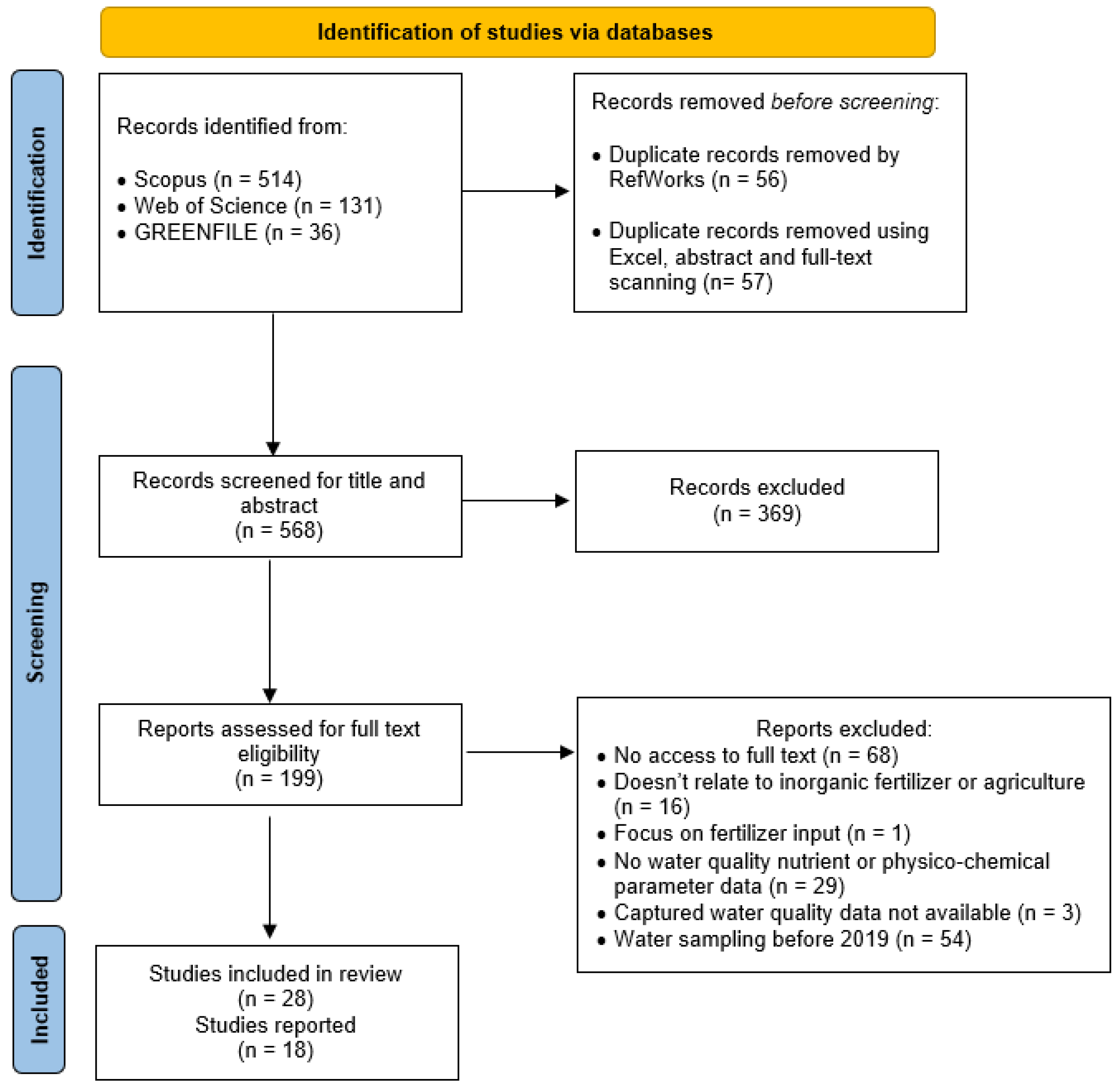
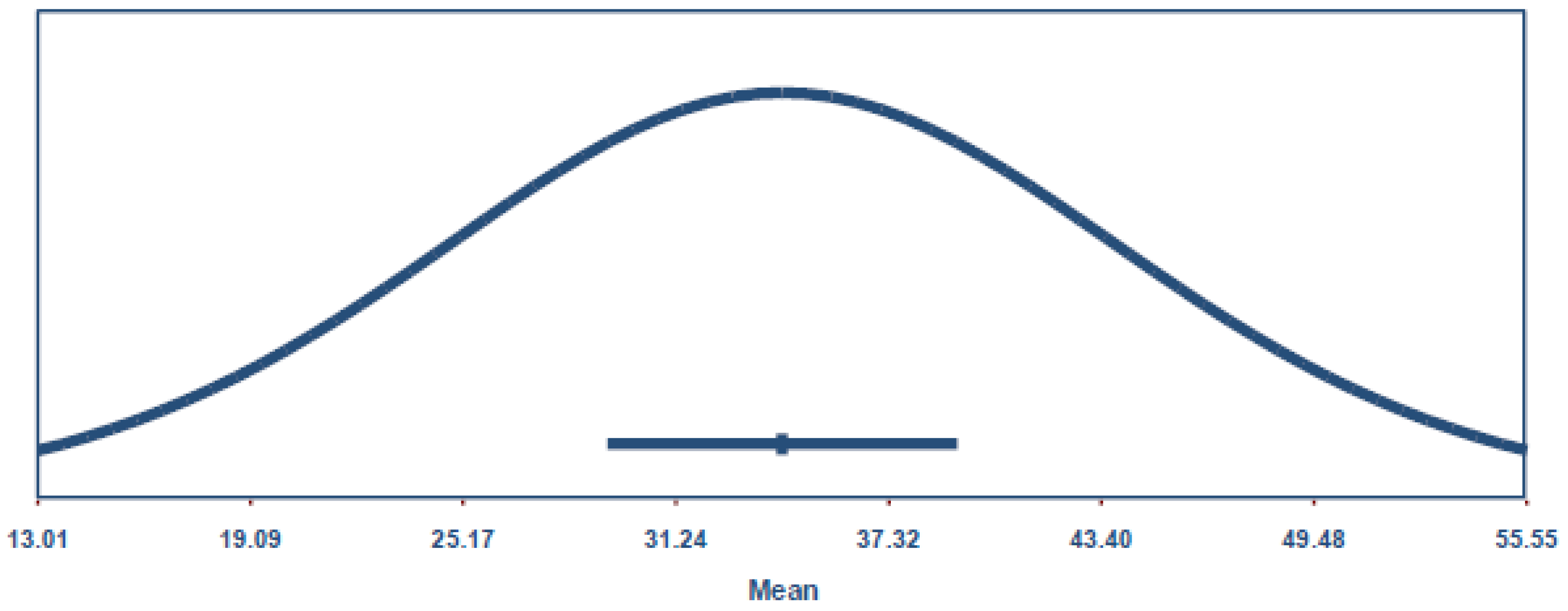
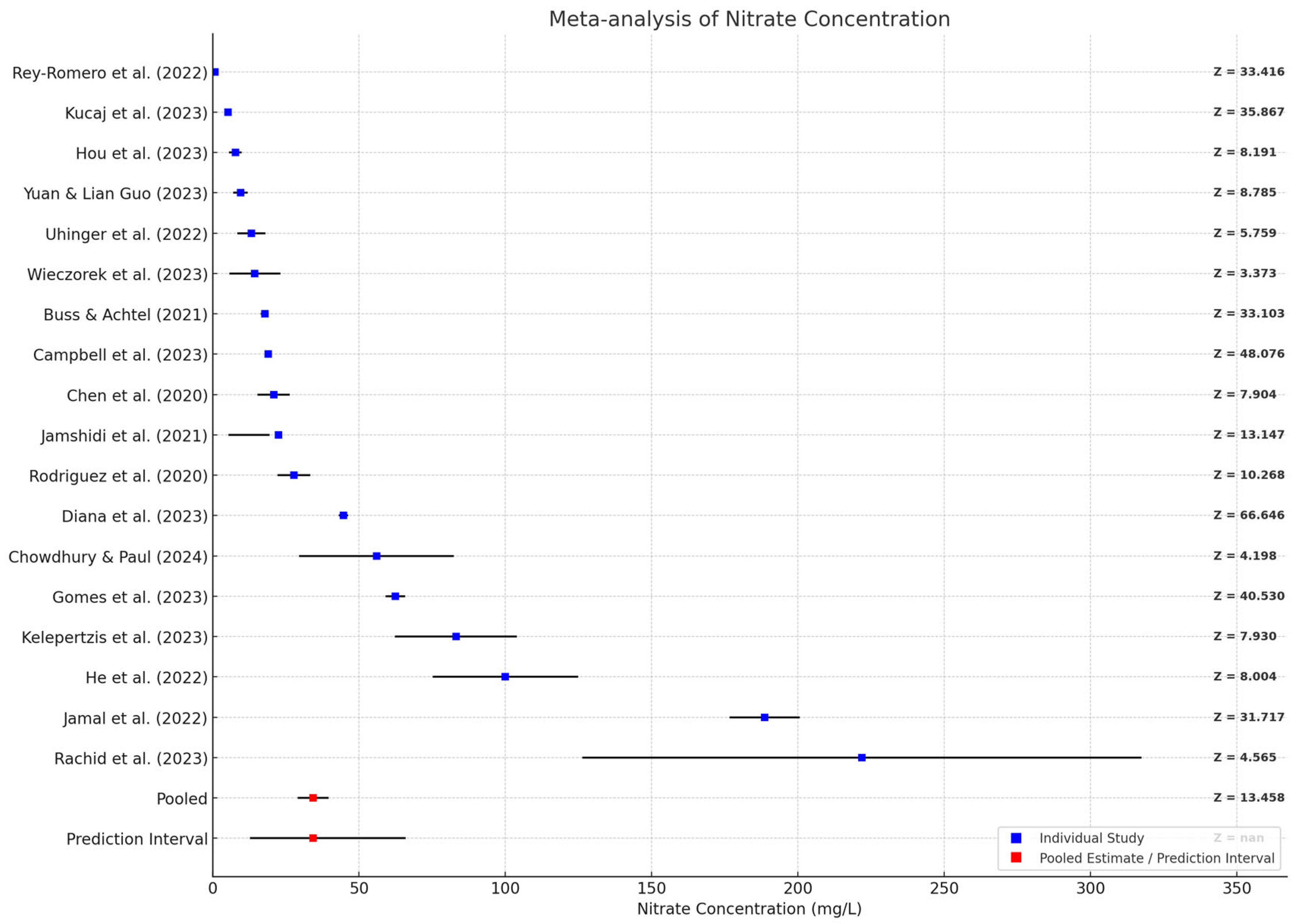

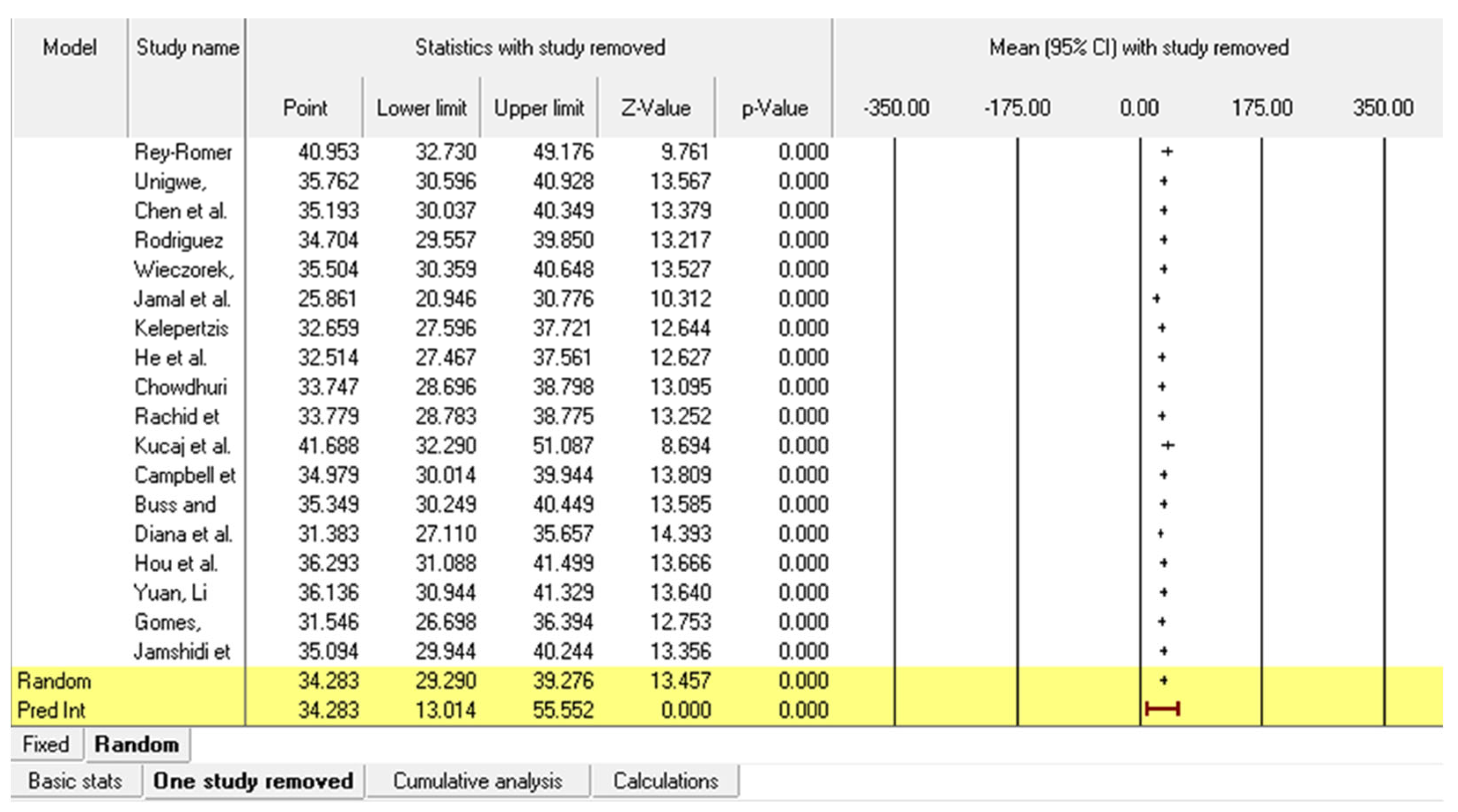
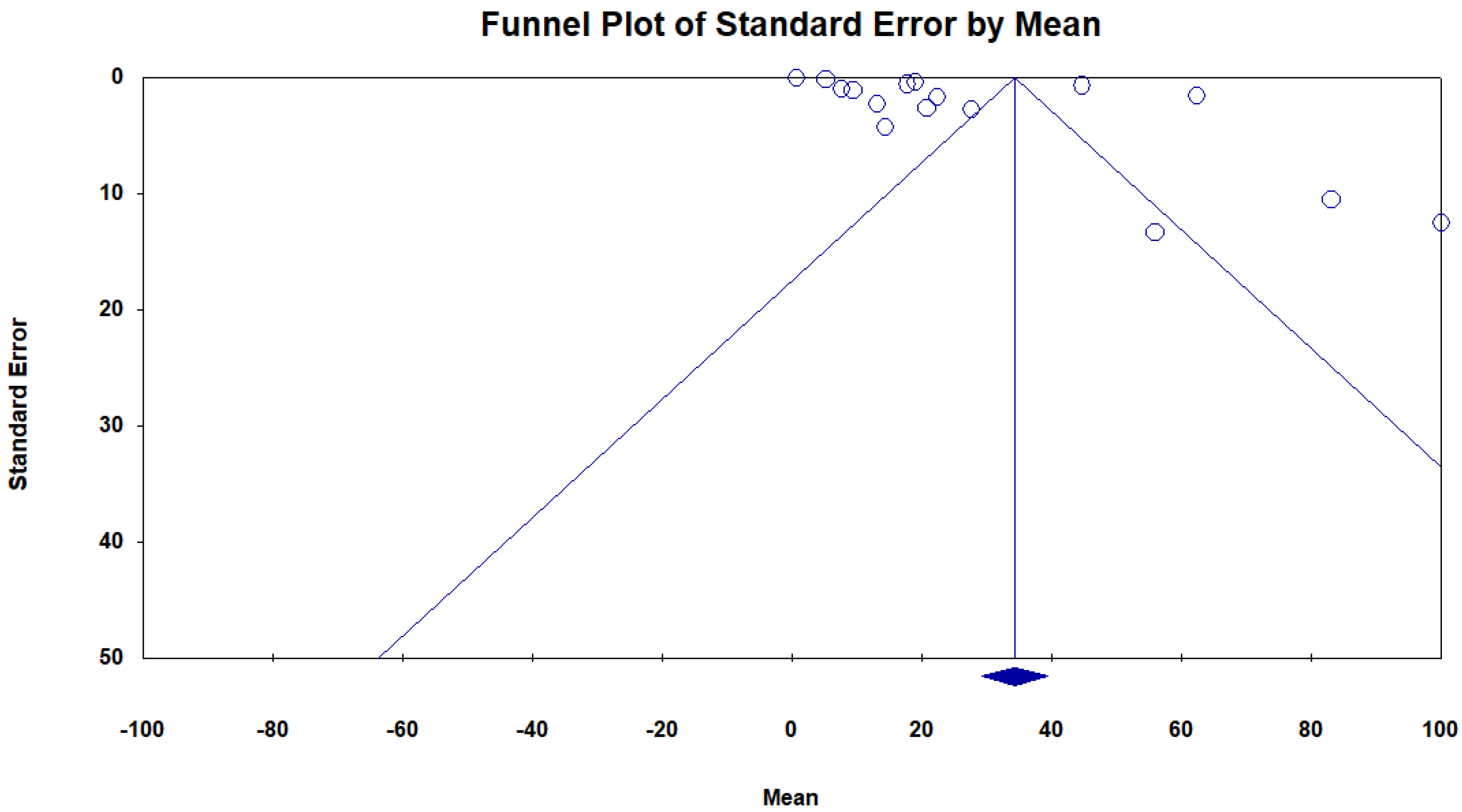
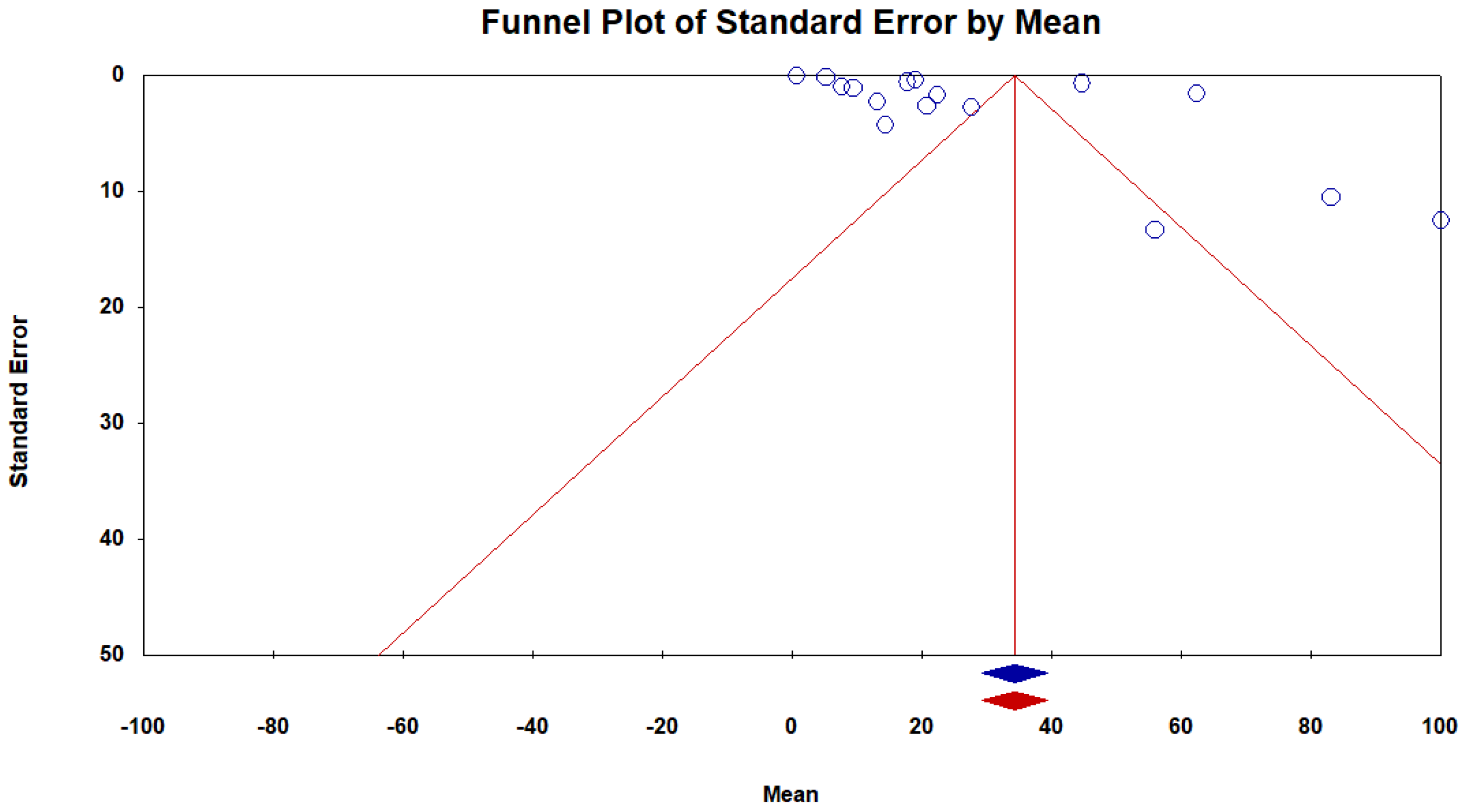
| S/N | Study | Sample Size | Mean * (mg/L NO3−) | SD * (mg/L NO3−) |
|---|---|---|---|---|
| 1 | [50] | 1728 | 62.4 | 64 |
| 2 | [33] | 10 | 5.24 | 0.462 |
| 3 | [51] | 10 | 44.68 | 2.12 |
| 4 | [52] | 344 | 19 | 7.33 |
| 5 | [53] | 80 | 7.72 | 8.43 |
| 6 | [54] | 37 | 55.97 | 81.09 |
| 7 | [55] | 36 | 0.763 | 0.137 |
| 8 | [56] | 17 | 14.38 | 17.58 |
| 9 | [57] | 41 | 83.1 | 67.1 |
| 10 | [58] | 19 | 13.16 | 9.96 |
| 11 | [59] | 519 | 17.8 | 12.25 |
| 12 | [60] | 20 | 221.81 | 217.28 |
| 13 | [61] | 122 | 100 | 138 |
| 14 | [62] | 7 | 188.57 | 15.73 |
| 15 | [63] | 45 | 22.42 | 11.44 |
| 16 | [64] | 58 | 20.84 | 20.08 |
| 17 | [65] | 120 | 27.69 | 29.54 |
| 18 | [66] | 204 | 9.46 | 15.38 |
Disclaimer/Publisher’s Note: The statements, opinions and data contained in all publications are solely those of the individual author(s) and contributor(s) and not of MDPI and/or the editor(s). MDPI and/or the editor(s) disclaim responsibility for any injury to people or property resulting from any ideas, methods, instructions or products referred to in the content. |
© 2025 by the authors. Licensee MDPI, Basel, Switzerland. This article is an open access article distributed under the terms and conditions of the Creative Commons Attribution (CC BY) license (https://creativecommons.org/licenses/by/4.0/).
Share and Cite
Adebanjo-Aina, O.; Oludoye, O. Impact of Nitrogen Fertiliser Usage in Agriculture on Water Quality. Pollutants 2025, 5, 21. https://doi.org/10.3390/pollutants5030021
Adebanjo-Aina O, Oludoye O. Impact of Nitrogen Fertiliser Usage in Agriculture on Water Quality. Pollutants. 2025; 5(3):21. https://doi.org/10.3390/pollutants5030021
Chicago/Turabian StyleAdebanjo-Aina, Opeyemi, and Oluseye Oludoye. 2025. "Impact of Nitrogen Fertiliser Usage in Agriculture on Water Quality" Pollutants 5, no. 3: 21. https://doi.org/10.3390/pollutants5030021
APA StyleAdebanjo-Aina, O., & Oludoye, O. (2025). Impact of Nitrogen Fertiliser Usage in Agriculture on Water Quality. Pollutants, 5(3), 21. https://doi.org/10.3390/pollutants5030021






